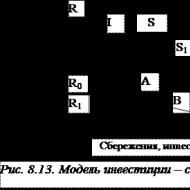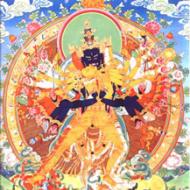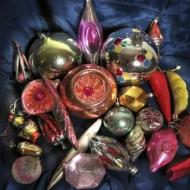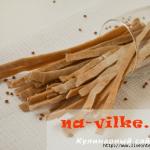
How to fight caterpillars on bird cherry. Bird cherry moth
Bird cherry ermine moth - Yponomeuta evonymellus (Linnaeus, 1758)
Signs: Wing length up to 1.3 cm.
The color is silvery-white with five longitudinal rows of small black dots. The hind wings are smoky brown with a dark border. They are wider and shorter than the front ones. The antennae are thin, thread-like, almost 2/3 the length of the wings. At rest, the wings are slightly curled and pressed to the body. When disturbed, the butterfly jumps to the side and falls to the ground.
Flight location: Floodplain forests, banks of streams with bushes and trees, gardens and parks.
Distribution: Almost all of Europe from floodplains to the border of deciduous forests.
Russia. Indochina, Japan.
Flight frequency: Varies greatly from year to year, but generally quite frequently until mass breeding. Then the food plants are completely eaten.
Flight time: From early July to mid-August. At night.
Caterpillar Stage: Young caterpillars overwinter on the buds and become active when the leaves open in the spring. They feed until the end of May or beginning of June and then pupate in a tightly packed collective nest, on a trunk or in the grass.
Food plants: Almost exclusively bird cherry (Prunus padus). Very rarely cherry or buckthorn. It eats only spring shoots, because the species does not produce a second generation. In England Prunus padus.
General information: At night, the butterfly willingly flies into the light. This moth demonstrates extraordinary adaptation to its host plant. After mating, which occurs a few days or weeks after the caterpillars hatch, the females search for overwintering buds and lay eggs on them. Soon caterpillars hatch from them, but they remain inactive and overwinter under the bud scales. When the buds begin to bloom in the spring, the caterpillars feed on the tender shoots. They grow quickly and at first stay together in a dense group, weaving a thin web around the shoot in the form of a nest, which becomes larger and denser as the caterpillars grow. If a tree is heavily infested with caterpillars, by mid-May it may turn silvery gray from spider nests. The web entangles not only the branches to the very top, but also the entire trunk to the very soil. This is the result of the activities of the entire caterpillar community. Yellowish caterpillars, strewn with black spots, envelop themselves in thin cobweb threads. Apparently, no bird eats them, because... they are very unpalatable due to the substances they absorb when feeding on bird cherry. Caterpillars gather in suitable places, such as in the forks of a trunk or on hollow stems. The strongest and largest ones pupate first. They weave a very dense silky cocoon in the middle of the loose shell of the nest and pupate in it. New caterpillars are constantly arriving, because... Up on the tree there is less and less food. Once the caterpillars have eaten enough food, they join others that have already formed cocoons, resulting in a thick nest containing up to a hundred caterpillars. The last caterpillars fail to create a cocoon. They are very skinny, because... they got too little food. And then they do something unexpected: they entwine the pupae of their more successful relatives with all the web that they are able to produce and then die. After a few weeks of the pupal stage, the butterflies hatch in midsummer. And the tree puts out new leaves, which are almost not eaten by other insects, because... leaves appear too late. Thanks to this, even if it is almost completely eaten, the tree does not die. True, with very severe damage it loses flowers and therefore does not bear fruit. But if later, in April, there are frosts or snow falls, then the young caterpillars that have become active will die. In such years, there is little damage to the leaves, and the trees suffer only from late-hatching caterpillars. Thus, the moth itself effectively performs biological self-regulation.
Control measures:
If there is a heavy infestation of moths, early spring treatment before the apple tree buds open with insecticides based on mineral oils and other recommended preparations. Repeated treatment with insecticides or biological preparations carried out against younger caterpillars in their nests. In individual and small gardens, removal of newly formed spider nests along with younger caterpillars, followed by their mechanical destruction. Collection and destruction of cocooned caterpillars in spider nests in cases where the pest developed unhindered on trees.
Spring always pleases with its warm and sunny weather after prolonged cold weather, but only gardeners and gardeners call this time special. The awakening of nature marks the beginning of a new planting season for them, and in order to get a good harvest in the fall, they have to try from the very beginning. Today there are a huge number of insects that have a negative impact on vegetable and fruit crops.
A big problem in achieving high-quality fruiting of trees and shrubs is pests, each of which requires its own approach. The ermine moth especially stands out among the rest. To get rid of it and save the harvest, the gardener should become familiar with the distinctive features of the insect.
Description of the species
The definition of "ermine moth" among biologists includes more than 600 species of lepidopteran moths. Almost all of them are very small in size and are common in the tropics, but some of the species have also chosen the middle zone, which is familiar to the inhabitants of Russia. In such a climate, the ermine moth feeds mainly on apple and bird cherry trees, but can also settle on other trees.
Small butterflies with a wingspan of 6-28 mm are capable of causing irreparable damage to adult plants, as a result of which trees die. Insects in large colonies can destroy entire gardens and forest belts. The moth feeds mainly on young green leaves, but can eat bark or roots to maintain vital functions. Insect caterpillars settle on the crown of a tree, gradually entwining it with a web and creating collective colonies. The web in them is so thick that it is impossible to see what is happening in the depths. In such nests, caterpillars pupate and become full-fledged butterflies, successors of the family. Sometimes colonies can number hundreds of insects, the damage from which can destroy a tree in one season.
Common types
In the climate of the middle zone, only 10 out of 600 species of this pest are common. Most often they settle on bird cherry or apple trees.
The apple ermine moth is distributed not only throughout Russian Siberia.
You can meet these insects in:
- Sweden;
- Great Britain;
- Canada;
- Finland;
- Japan and Korea.
Due to the seasonality of pest attacks, moths are often called the “May worm.”
The ermine bird cherry moth is found over a wider area. Insects are capable of harming forest plantations throughout the Caucasus and most of Russia, right up to China itself.
The peculiarity of pests is that after several years of diligent efforts to destroy gardens, they disappear by themselves. Slightly damaged trees can quickly recover from such attacks, but some may not survive. To reduce losses of crops and trees themselves, gardeners are often interested in how to deal with ermine moths? In fact, everything is not so simple, and most chemicals simply do not work on insects, but regular treatment of plants still speeds up the process of pest disappearance.
Outbreaks of insect activity

The peculiarity of the life activity of moths is that every few years their populations migrate and infect various cities and regions of the country. The first outbreaks of insect activity were noticed in the eighties, after which the ermine moth was noted only in the mid-nineties. The European part of the country is most susceptible to pest attacks in the Moscow and Leningrad regions. The end of the nineties was marked by an active proliferation of the moth population in the Krasnodar region, which damaged many trees. After this, the pests sharply became more active in Khanty-Mansiysk, and in 2006 they attacked the gardens of Sweden. The last extensive epidemic was noted in Irkutsk 5 years ago.
Observing the reproduction and movement of the moth, you can notice that its population is growing every season and will soon infect entire forest plantations and gardens at once. Active control of ermine moths does not lead to significant results, and the insects return again with renewed vigor, developing immunity to the chemicals used. Only when natural migration is necessary do all pests abruptly leave their habitat. Typically, moths live in one place for no more than five years.
Appearance of insects
Ermine moth, the control methods for which need to be tightened every year, is not very attractive. The color of the butterflies is dull, but quite cute. Insects with white front wings and gray hind wings are common throughout our country. The white wings of butterflies have several rows of black dots, and the backs of all the wings are painted gray. Pests are nocturnal during this developmental phase.
Moth caterpillars also have rows of dots along the body, located on the sides. The main color is yellow-gray, and the head, legs and speckles of the caterpillars are black.
Lifespan
Like most insects, the ermine moth lives only one year on apple and bird cherry trees. To continue the species, before the cold weather, butterflies lay eggs on the trunks of their home trees and cover future offspring with protective mucus. Within a few weeks, under such a shield, larvae appear from the eggs, which live all winter, feeding on tree bark and the remains of their shell. Only with the onset of warmth and the appearance of leaves on the tree can you notice an increase in the activity of caterpillars. First, they eat the inner parts of the foliage, leaving their outer shells intact, and then they move to the surface and begin to entangle the tree crowns with a thick web.
Such spider colonies can be seen already at the end of May. They appear mainly at the tops of plants, gradually expanding throughout the tree. When the web completely covers most of the mother plant, the caterpillars pupate, settling in small groups in the forks of the branches. A new generation of butterflies is born at the end of June.
Possible damage

Even the seemingly useless fight against ermine moths on apple trees is necessary, since in the absence of resistance to the pest, an overgrown colony can lead to the death of entire orchards. The life cycle of insects boils down to regularly eating tree leaves, first from the inside and then from the outside. In any case, if the green mass is damaged, photosynthesis becomes impossible, and the plants are not able to develop, grow, bloom and bear fruit. To recover from such an invasion, crops need more than one year.
In cities, after an active growth in the population of ermine moths, they begin to actively fight also because of the unsightliness of green spaces at this time. All of them are densely entangled in cobwebs and look very depressing on city streets.
Options for fighting
Despite the fact that it is necessary to combat this pest, there is simply no effective remedy for this. Plants can be saved only by timely preventive treatment or timely spraying, even before the caterpillars begin to weave around the crowns.
For this purpose, you can select any chemical insecticides, the main thing is to change them periodically so as not to cause insects to become addicted to the active ingredient. Manual collection of spider nests is also considered effective, of course, if there are not too many of them. After cleaning the tree, all caterpillars along with the cobwebs must be burned immediately. Pheromone traps for female moths are also considered effective.
Chemicals

Most often, chemical mixtures are used to combat moths. In private gardens, Actellik is suitable for this, but you should work with it carefully, since the drug is very toxic.
If there are only a few spider nests on the tree, then treatment with the following drugs will give the result:
- "Danadim";
- "Lepidocide";
- "Bitoxibacillin."

In other cases, it is best to spray the plants:
- Bordeaux mixture;
- arsenic solution;
- Parisian greens.
The first spraying of infected trees must be carried out strictly before flowering or after it. Most often this time is in early May. During flowering and immediately after treatment, it is only allowed to manually collect caterpillars and cocoons. Repeated spraying should be carried out during the period when butterflies lay eggs. This usually happens already in July.
Traditional methods

In addition to actively spreading chemicals to control pests, many gardeners use products that are gentler on plants, but no less effective. Among such recipes for spray mixtures, a composition based on red pepper is very common. To prepare it, add a pack of ground red pepper, a pack of shag, a whole bottle of potassium permanganate and a little onion or garlic peel into 1 bucket of water. The infusion must be left for 3 days, after which it can be used. Many people decide to spray their trees with regular Coca-Cola, saying that the effect is no worse.
You can fight moths not only by baiting. To do this, the tree trunk is wrapped with tape with the sticky side facing out and changes as it fills with insects. By the way, any insects can fall into such a sticky trap.
Conclusion

Pest infestations are part of a natural process, so it is impossible to completely get rid of them. To reduce crop losses and minimize harm to the plants themselves, it is necessary to begin eliminating pests from the site in a timely manner. This must be done until all individuals disappear, since the moth can attack any crop in search of food.
The control methods listed above can also be used for invasions of other insects. The most important thing is that you need to choose the most effective means to get rid of pests, and then you will be guaranteed a good harvest.
A few years ago I planted a bird cherry tree near the fence. This year it bloomed for the first time.“Once upon a time in our village there was a bird cherry tree growing near every house. But it did not always bear fruit, and there were a lot of aphids on it. Therefore, the owners began to gradually part with it, replacing it with lilac. The most patient ones cut down the trees only after they had stood for half the summer, completely covered with some kind of white-gray cobweb. The sight was terrible. They didn’t know what would happen next to the bird cherry tree, so they cut it down together, some taller, some closer to the ground. But what’s surprising is that for those owners who never found the time to uproot the remains of the bird cherry tree, after a few years it came to life and even pleased with the berries,” a friend told me when she saw a blooming bird cherry tree on my plot. I also happened to see a similar picture once - in the middle of summer, bird cherry trees tangled in a white, or rather, gray web. Some caterpillars were crawling around in it. As it turned out, it was an outbreak of bird cherry ermine moth breeding. So sometimes harmless, even cute-looking butterflies become the cause of real disaster.
Dangerous moth
This moth has adapted to life on bird cherry trees. In the summer, after mating, which occurs a few days or weeks after the butterflies hatch, the females look for overwintering buds and lay eggs on them. Soon caterpillars emerge from them, preferring to remain invisible until next summer and overwinter under the bud scales. In the spring, when the buds begin to bloom, the caterpillars move to the tender shoots that are beginning to grow. They grow quickly and initially stick together in a dense group, entwining the shoot with a thin web in the form of a nest, which becomes larger and denser as the caterpillars grow. With the massive development of caterpillars, the tree can become silver-gray from cobweb nests, as if it were a solid cocoon. In this case, the web entangles not only the branches to the very top, but also the entire trunk to the very soil, and sometimes spreads to objects located near the trunk, such as bicycles. My friend and I observed this picture in different places in the Arkhangelsk region.Birds are too tough
This cocoon on the tree is the result of caterpillar activity. They are yellowish, strewn with black spots, and wrap themselves in thin cobweb threads. Almost no one eats them, since birds cannot break through the dense web and destroy the caterpillars. Even after the butterflies have flown out, the trees remain in the threads tightened on their trunks until autumn. The caterpillars gather in the forks of the trunk or on bare branches. The strongest and largest ones pupate first. They weave a very dense silky cocoon in the middle of the loose shell of the nest and pupate in it. Once the caterpillars have eaten enough food, they join others that have already formed cocoons, resulting in a thick nest containing up to a hundred caterpillars. Gradually, at the top, on the tree, there are fewer and fewer leaves; the last caterpillars fail to create a cocoon, since they do not have enough nutrition to accumulate strength for further transformation. And they die nobly, while entwining the pupae of their more successful relatives with all the web that they are capable of producing. A few weeks later the butterflies fly out and everything repeats again. And by this time the tree blooms new leaves, which remain untouched, since there are no more caterpillars. The tree most often with difficulty, but still straightens itself.Nature regulates
This butterfly is very widespread. Its habitat includes almost all of Europe, as well as Russia, Indochina, and Japan. From time to time, this species experiences mass reproduction of larvae. Outbreaks of cherry tree ermine infestation of bird cherry trees occur periodically, and it is impossible to predict the next outbreak. Late spring frosts and bird cherry cold, which almost always accompany bird cherry blossoms, cause the death of the most nimble caterpillars, thereby significantly reducing the army of bird cherry ermine moths. For procreation, only those caterpillars that hatch after the end of frost remain - this mechanism for regulating the number of pests is determined by nature itself.Control measures
Considering that bird cherry ermine moth caterpillars are quite highly sensitive to biological products based on entomopathogenic bacteria, treatments with the biological product lepidocid against younger caterpillars are quite effective. You can also cut off the cocoons one by one along with the voracious creatures and be sure to burn them, pour boiling water on them or destroy them in another way. As a preventative measure, trees are sprayed in the spring with preparations (confidor, karate, lepidocide, fitoverm) before the leaves have fully blossomed. In this case, chemical preparations can be sprayed once, but biological preparations (the last two) will have to be repeated every ten days in dry, windless weather.Left without berries
My bird cherry tree has bloomed. But instead of berries, I saw some strange pods. It seemed like there was some kind of cross-pollination with the beans. In fact, the bird cherry fruits acquired such an ugly shape under the influence of a parasitic fungus, which is called plum pockets, or, popularly, dutiki, due to the fact that it causes ugly growth of the fruits. The mycelium of this mushroom overwinters in the crown of trees, cracks in the bark and between the scales of the buds. In spring, it quickly continues its development in the tissues of the future ovary. If you look closely at the flowers, you will notice signs of abnormality: the petals have not yet fallen, but the stamens and pistils have increased significantly in size, and the ovaries have swollen. Similar changes in fruit shape are observed on plum and cherry plum. Elongated yellowish-white ovaries, curved and covered with wrinkles, most often fall off along with the barren flower, but sometimes they flaunt on the tree for some time, surprising with the bizarreness of their shapes and upsetting the loss of the harvest.The mushroom is to blame
Plum pockets are a widespread fungal disease of stone fruits. When severely developed, the disease causes significant losses, since the affected fruits are unfit for consumption. The length of the affected fruits sometimes reaches 3 cm, they are irregular in shape, sometimes curved, fleshy, but not juicy. There is no seed, which is why the flesh inside the fruit is wrinkled and greenish in color. At the end of June - beginning of July, the surface of the affected fruits is covered with a whitish-gray waxy coating of marsupial sporulation of the fungus. The spores disperse and end up in the folds of the bark and on the buds, where they overwinter. The mycelium also overwinters on the affected branches. In the spring, during the flowering of bird cherry, the flowers become infected, from which blown fruits develop. Infection can also occur with overwintered mycelium, which in the spring from the shoot along the pedicels enters the flowers. The fungus develops in one generation, and the disease does not spread in summer. A large number of “pockets” develop mainly in cool and damp weather, and the flowering of bird cherry, as a rule, coincides with a cold snap. When the disease develops strongly on trees, more than 50-60 percent of the affected fruits occur.Control measures
It is possible to prevent the spread of the disease in the area, but you will have to try hard to do this. First, you need to carefully remove and burn diseased pocket fruits (both those that have fallen to the ground and those remaining on the branches) until they begin to “gather dust.” This is especially difficult to do on large trees. Therefore, it is easier to trim and burn the branches that have pockets, which is what I did this year. At this time, a neighbor passed by and said that the elongated fruits on the bird cherry tree were the result of under-pollination and there was no point in fighting it. And when I tried to prove to him that this was a dangerous disease, he, citing the authority of some Vasily, left with his own opinion. The spores of this fungus are volatile, and given that the neighbors will not protect their trees, next spring you will have to treat them with pesticides. Trees are sprayed against plum pockets three times: before buds open, with a 0.75-1 percent solution of copper sulfate; during the period of kidney swelling with 3% Bordeaux mixture; immediately after flowering, spraying with 1% Bordeaux mixture, 0.3% copper oxychloride or another fungicide is effective. In addition, it is taken into account that varieties with a late and extended flowering period are more affected and, conversely, varieties with a short and early flowering period are less affected.Another misfortune
It is also not recommended to plant ordinary bird cherry on the site because a dangerous pest of black currant - glassberry, which manifests itself in the form of drying branches, flowers and berries, overwinters on it. If you cut off a damaged currant branch, a black cavity will open inside, eaten away by the pest's caterpillar. In the spring (during cherry blossoms), when the glass flies from the bird cherry to the currant, the bushes are sprayed with infusions with a pungent odor (pine needles, garlic, tansy, citrus peels) to disorient the pest. Having discovered damaged branches, they are cut out and burned. I'm sorry to part with the bird cherry. She's so dressed up for spring! Therefore, I’ll try to fight for it - it’s never too late to cut it down, but my hand doesn’t rise. In the meantime, the red Virginia bird cherry is growing, which pests and diseases like less.Signs: Wing length up to 1.3 cm.
The color is silvery-white with five longitudinal rows of small black dots. The hind wings are smoky brown with a dark border. They are wider and shorter than the front ones. The antennae are thin, thread-like, almost 2/3 the length of the wings. At rest, the wings are slightly curled and pressed to the body. When disturbed, the butterfly jumps to the side and falls to the ground.
Flight location: Floodplain forests, stream banks with bushes and trees, gardens and parks.
Almost all of Europe from the floodplains to the border of deciduous forests.
Russia. Indochina, Japan.
Flight frequency: It fluctuates greatly in different years, but generally quite often until mass reproduction. Then the food plants are completely eaten.
Summer time: From early July to mid-August. At night.
Caterpillar stage: Young caterpillars overwinter on the buds and become active when the leaves open in the spring. They feed until the end of May or beginning of June and then pupate in a tightly packed collective nest, on a trunk or in the grass.
Forage plants: Almost exclusively bird cherry (Prunus padus). Very rarely cherry or buckthorn. It eats only spring shoots, because the species does not produce a second generation. In England Prunus padus.
General information: At night, the butterfly willingly flies into the light. This moth demonstrates extraordinary adaptation to its host plant. After mating, which occurs a few days or weeks after the caterpillars hatch, the females search for overwintering buds and lay eggs on them. Soon caterpillars hatch from them, but they remain inactive and overwinter under the bud scales. When the buds begin to bloom in the spring, the caterpillars feed on the tender shoots. They grow quickly and at first stay together in a dense group, weaving a thin web around the shoot in the form of a nest, which becomes larger and denser as the caterpillars grow. If a tree is heavily infested with caterpillars, by mid-May it may turn silvery gray from spider nests. The web entangles not only the branches to the very top, but also the entire trunk to the very soil. This is the result of the activities of the entire caterpillar community. Yellowish caterpillars, strewn with black spots, envelop themselves in thin cobweb threads. Apparently, no bird eats them, because... they are very unpalatable due to the substances they absorb when feeding on bird cherry. Caterpillars gather in suitable places, such as in the forks of a trunk or on hollow stems. The strongest and largest ones pupate first. They weave a very dense silky cocoon in the middle of the loose shell of the nest and pupate in it. New caterpillars are constantly arriving, because... Up on the tree there is less and less food. Once the caterpillars have eaten enough food, they join others that have already formed cocoons, resulting in a thick nest containing up to a hundred caterpillars. The last caterpillars fail to create a cocoon. They are very skinny, because... they got too little food. And then they do something unexpected: they entwine the pupae of their more successful relatives with all the web that they are able to produce and then die. After a few weeks of the pupal stage, the butterflies hatch in midsummer. And the tree puts out new leaves, which are almost not eaten by other insects, because... leaves appear too late. Thanks to this, even if it is almost completely eaten, the tree does not die. True, with very severe damage it loses flowers and therefore does not bear fruit. But if later, in April, there are frosts or snow falls, then the young caterpillars that have become active will die. In such years, there is little damage to the leaves, and the trees suffer only from late-hatching caterpillars. Thus, the moth itself effectively performs biological self-regulation.
It’s May, everything around is blooming and fragrant, the garden is pleasing to the eye... And suddenly you notice a web on the bird cherry bushes... No, these are not those silky threads that harmless spiders pull. White dense cocoons are what will alarm you. Things can go so far that the entire bush will be shrouded in a cobweb. What happens to the bird cherry? What kind of trouble can you expect from this web?
Special signs
Ermine moths– small, mainly crepuscular and nocturnal butterflies. The wings are narrow, varied in color, in some species white with black dots, reminiscent of an ermine mantle. Caterpillars up to 18 mm long, often yellowish or greenish, live in colonies in web nests, which often envelop entire trees and bushes.
To the family ermine moths ( Yponomeutidae) besides bird cherry moth ( Yponomeuta evonymella) relate: apple moth ( Yponomeuta malinellus), fruit moth ( Yponomeuta padella), willow web moth ( Yponomeuta rorella), euonymus ermine moth ( Yponomeuta cognatellus), cherry shoot moth ( Argiresthia pruniella), cabbage moth ( Plutella xylostella) and other types.

Butterflies of bird cherry, apple, euonymus, willow and fruit spider moths are clearly distinguished from the others by the silvery-white color of the fore wings covered with black dots. The wing pattern is characteristic of the species and may, for example, consist of 12–16 black dots arranged in three irregular rows (apple moth), or 45–58 black dots arranged in five irregular rows (bird cherry ermine moth).

The caterpillars are yellowish in color and have longitudinal rows of dark dots on their backs. They live in spider nests where they pupate. Before pupation, each caterpillar spins a separate white cocoon.
From spider's nests
Caterpillars of the first instar of the bird cherry ermine moth overwinter under the scutes. They emerge from under them in the first half of May and immediately weave web nests. There are 15–45 caterpillars in one nest. They pupate in the second half of June in white dense cocoons arranged in compact packs.

Ermine moth caterpillars
The flight of butterflies occurs in July–August. During the day they sit motionless, often on the underside of leaves and in shaded places on branches; active flight begins before dusk and continues until dark.

Ermine moth butterflies
Two weeks after emerging from the pupae, the butterflies mate (usually in the evening) and after 5–6 days the females begin to lay eggs (finished in the second half of July) in groups (10–25 pieces each) on bird cherry branches, covering the oviposition with a shield. The hatched caterpillars remain for the winter.
When it's warm and damp
Mass reproduction of bird cherry ermine moths is facilitated by certain meteorological conditions - warm winters, mild springs, wet summers. This is exactly the situation that developed in 2005. Residents of Moscow and the Moscow region were concerned about damage to trees by insects eating foliage and entangling entire trees and bushes in thick webs. This trouble was caused by the massive reproduction of bird cherry ermine moth. Damage to trees by these butterflies has repeatedly occurred before, but to a lesser extent.

Bird cherry damaged by ermine moth
At the same time, fruit moths were observed eating the leaves of apple trees. This type of insect, just like the bird cherry ermine moth, entangles the foliage and shoots of trees it eats with a web and, after stopping feeding, pupates in woven nests in white spindle-shaped cocoons.
For Moscow and the Moscow region, even the mass reproduction of bird cherry ermine moth is not a very dangerous phenomenon. These insects cannot cause much damage to the plantings; the trees will restore their foliage within the year of damage. But bushes shrouded in cobwebs, eaten leaves and shoots are not a pleasant sight.

Web nest of bird cherry moth
How to fight
Chemical treatment of damaged trees and shrubs is not very effective, since the caterpillars are well protected by a dense web. We can recommend collecting and destroying spider nests with caterpillars, without waiting for noticeable eating of the foliage.
________________________________________________________________

















